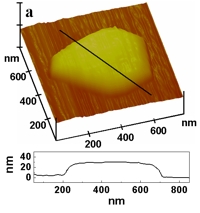
1Nanoscience Group, Materials Chemistry Division and
2Biochemical Sciences Division, National Chemical Laboratory, Pune – 411 008, India
e-mail: sastry@ems.ncl.res.in

 |
S. Shiv Shankar1, Akhilesh Rai1, Absar Ahmad2, and Murali Sastry1
1Nanoscience Group, Materials Chemistry Division and e-mail: sastry@ems.ncl.res.in |
 |
Anisotropic metal nanoparticles have distinct optical properties that are considerably different than their spherical counterparts. We have recently reported a simple biological method involving the reduction of aqueous gold ions by the extract of the lemongrass plant leading to the formation of gold nanotriangles with interesting absorption in the near infrared (NIR) region of the electromagnetic spectrum [1]. In this paper, we show that by simple variation of the experimental conditions, it is possible to vary the size of the gold nanotriangles and thus, to tune the absorbance of flat gold nanoparticles in the NIR region. The NIR absorption of the gold nanotriangles is expected to be of application in hyperthermia of cancer cells [2] and in IR absorbing optical coatings. We show that the biologically synthesized gold nanotriangles can be easily cast in the form of films on glass substrates and that these films are highly efficient in absorbing IR radiation for potential architectural applications. It is observed that in comparison to spherical gold nanoparticles, gold nanotriangles as coatings on window glass are able reduce the rise in temperature inside an enclosed compartment on exposure to visible and NIR radiation through the coated windows.